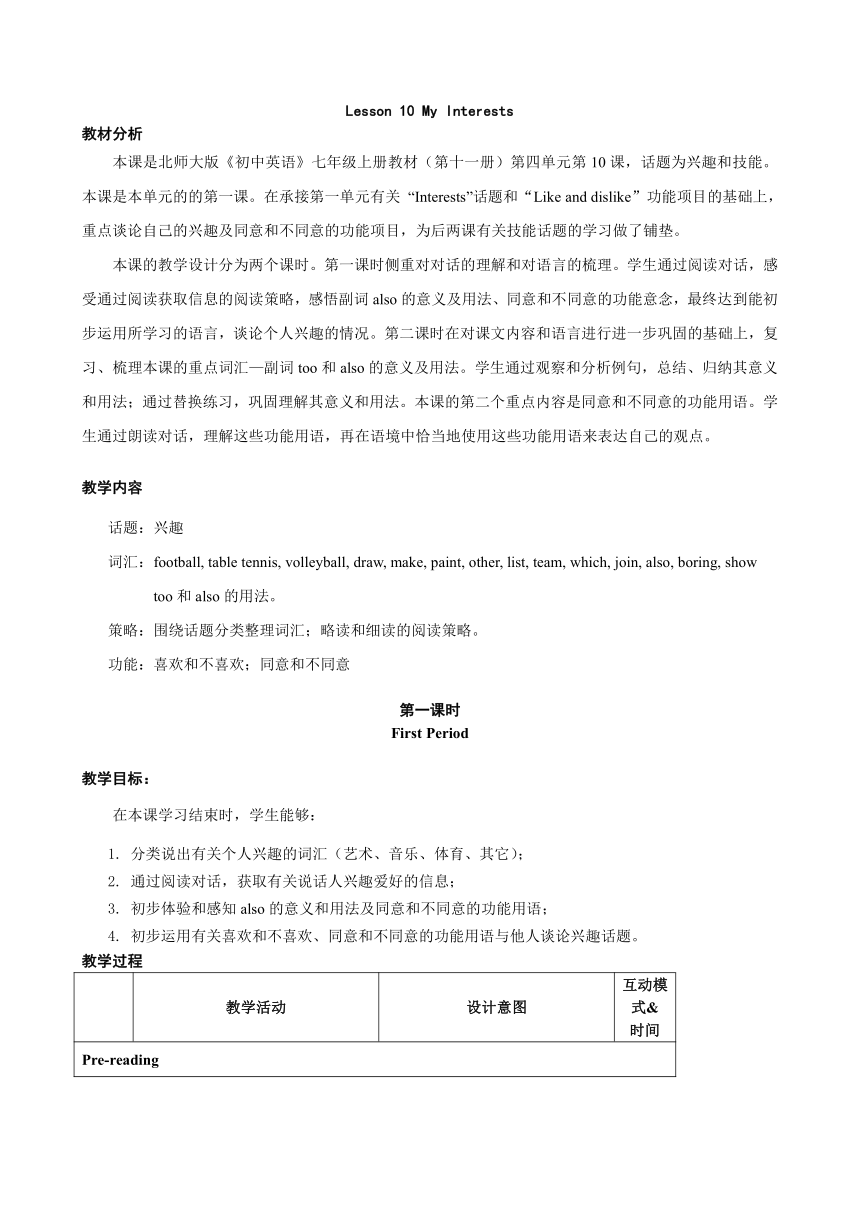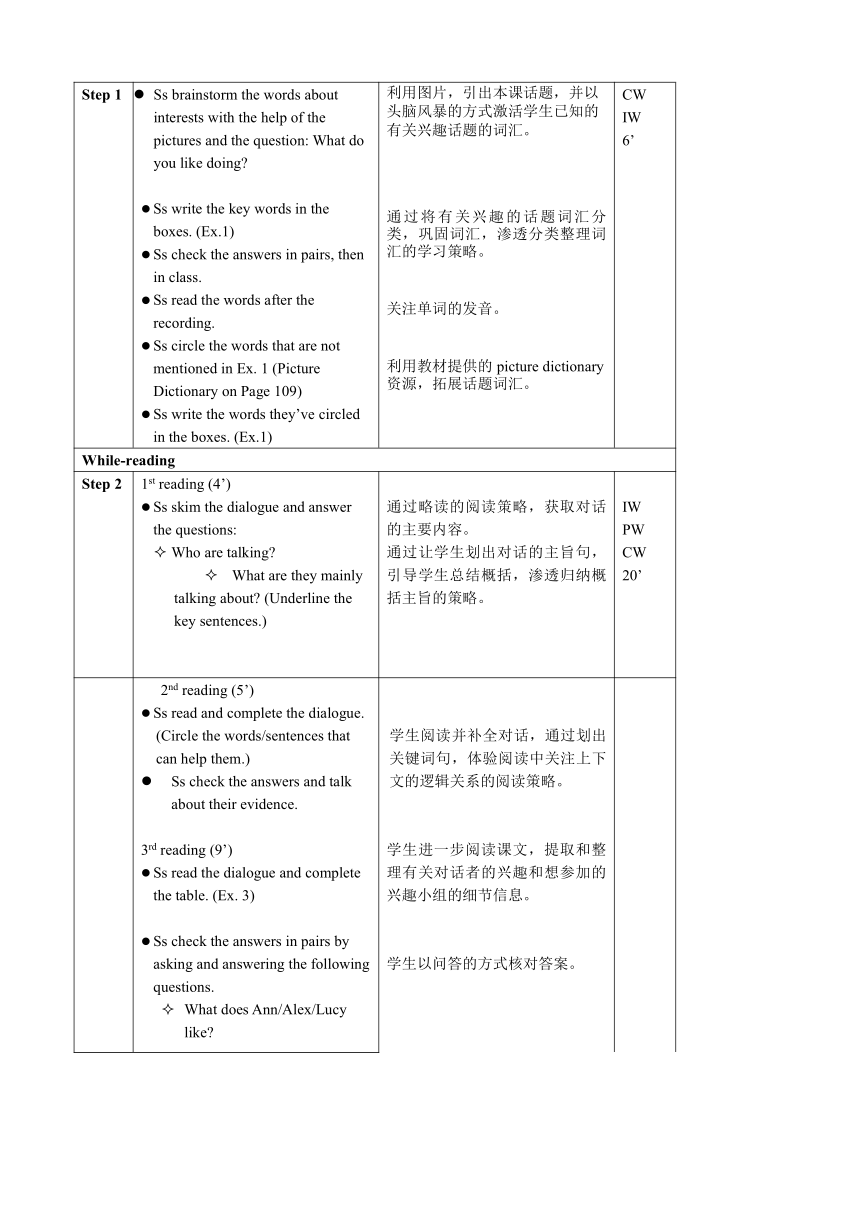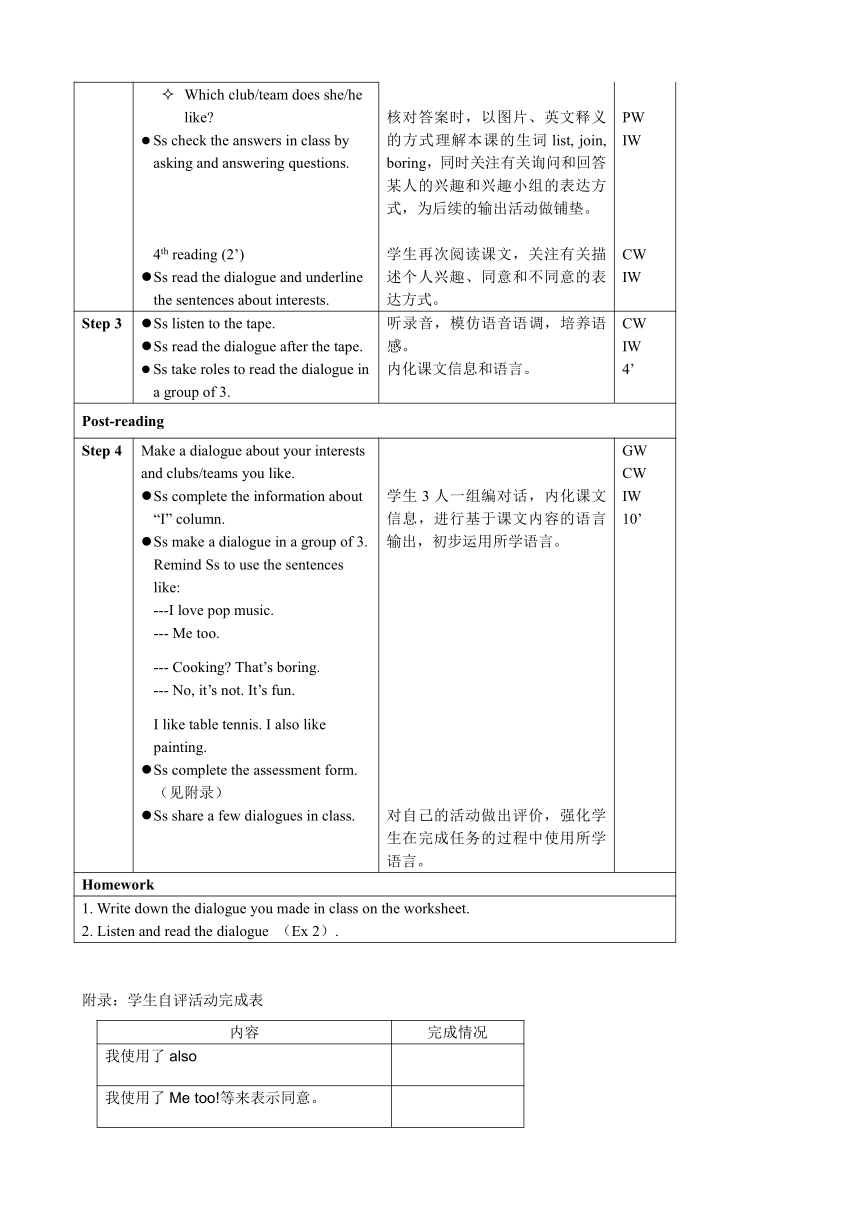Unit 4 Interests and Skills Lesson 10 My Interests 教案(2课时)
文档属性
| 名称 | Unit 4 Interests and Skills Lesson 10 My Interests 教案(2课时) |  | |
| 格式 | doc | ||
| 文件大小 | 28.4KB | ||
| 资源类型 | 教案 | ||
| 版本资源 | 北师大版 | ||
| 科目 | 英语 | ||
| 更新时间 | 2021-09-26 16:29:25 | ||
图片预览



文档简介
Lesson
10
My
Interests
教材分析
本课是北师大版《初中英语》七年级上册教材(第十一册)第四单元第10课,话题为兴趣和技能。本课是本单元的的第一课。在承接第一单元有关
“Interests”话题和“Like
and
dislike”功能项目的基础上,重点谈论自己的兴趣及同意和不同意的功能项目,为后两课有关技能话题的学习做了铺垫。
本课的教学设计分为两个课时。第一课时侧重对对话的理解和对语言的梳理。学生通过阅读对话,感受通过阅读获取信息的阅读策略,感悟副词also的意义及用法、同意和不同意的功能意念,最终达到能初步运用所学习的语言,谈论个人兴趣的情况。第二课时在对课文内容和语言进行进一步巩固的基础上,复习、梳理本课的重点词汇—副词too和also的意义及用法。学生通过观察和分析例句,总结、归纳其意义和用法;通过替换练习,巩固理解其意义和用法。本课的第二个重点内容是同意和不同意的功能用语。学生通过朗读对话,理解这些功能用语,再在语境中恰当地使用这些功能用语来表达自己的观点。
教学内容
话题:兴趣
词汇:football,
table
tennis,
volleyball,
draw,
make,
paint,
other,
list,
team,
which,
join,
also,
boring,
show
too和also的用法。
策略:围绕话题分类整理词汇;略读和细读的阅读策略。
功能:喜欢和不喜欢;同意和不同意
第一课时
First
Period
教学目标:
在本课学习结束时,学生能够:
1.
分类说出有关个人兴趣的词汇(艺术、音乐、体育、其它);
2.
通过阅读对话,获取有关说话人兴趣爱好的信息;
3.
初步体验和感知also的意义和用法及同意和不同意的功能用语;
4.
初步运用有关喜欢和不喜欢、同意和不同意的功能用语与他人谈论兴趣话题。
教学过程
教学活动
设计意图
互动模式&
时间
Pre-reading
Step
1
Ss
brainstorm
the
words
about
interests
with
the
help
of
the
pictures
and
the
question:
What
do
you
like
doing?
Ss
write
the
key
words
in
the
boxes.
(Ex.1)
Ss
check
the
answers
in
pairs,
then
in
class.
Ss
read
the
words
after
the
recording.
Ss
circle
the
words
that
are
not
mentioned
in
Ex.
1
(Picture
Dictionary
on
Page
109)
Ss
write
the
words
they’ve
circled
in
the
boxes.
(Ex.1)
利用图片,引出本课话题,并以头脑风暴的方式激活学生已知的有关兴趣话题的词汇。
通过将有关兴趣的话题词汇分类,巩固词汇,渗透分类整理词汇的学习策略。
关注单词的发音。
利用教材提供的picture
dictionary资源,拓展话题词汇。
CW
IW
6’
While-reading
Step
2
1st
reading
(4’)
Ss
skim
the
dialogue
and
answer
the
questions:
Who
are
talking?
What
are
they
mainly
talking
about?
(Underline
the
key
sentences.)
通过略读的阅读策略,获取对话的主要内容。
通过让学生划出对话的主旨句,引导学生总结概括,渗透归纳概括主旨的策略。
IW
PW
CW
20’
2nd
reading
(5’)
Ss
read
and
complete
the
dialogue.
(Circle
the
words/sentences
that
can
help
them.)
Ss
check
the
answers
and
talk
about
their
evidence.
3rd
reading
(9’)
Ss
read
the
dialogue
and
complete
the
table.
(Ex.
3)
Ss
check
the
answers
in
pairs
by
asking
and
answering
the
following
questions.
What
does
Ann/Alex/Lucy
like?
Which
club/team
does
she/he
like?
Ss
check
the
answers
in
class
by
asking
and
answering
questions.
4th
reading
(2’)
Ss
read
the
dialogue
and
underline
the
sentences
about
interests.
学生阅读并补全对话,通过划出关键词句,体验阅读中关注上下文的逻辑关系的阅读策略。
学生进一步阅读课文,提取和整理有关对话者的兴趣和想参加的兴趣小组的细节信息。
学生以问答的方式核对答案。
核对答案时,以图片、英文释义的方式理解本课的生词list,
join,
boring,同时关注有关询问和回答某人的兴趣和兴趣小组的表达方式,为后续的输出活动做铺垫。
学生再次阅读课文,关注有关描述个人兴趣、同意和不同意的表达方式。
PW
IW
CW
IW
Step
3
Ss
listen
to
the
tape.
Ss
read
the
dialogue
after
the
tape.
Ss
take
roles
to
read
the
dialogue
in
a
group
of
3.
听录音,模仿语音语调,培养语感。
内化课文信息和语言。
CW
IW
4’
Post-reading
Step
4
Make
a
dialogue
about
your
interests
and
clubs/teams
you
like.
Ss
complete
the
information
about
“I”
column.
Ss
make
a
dialogue
in
a
group
of
3.
Remind
Ss
to
use
the
sentences
like:
---I
love
pop
music.
---
Me
too.
---
Cooking?
That’s
boring.
---
No,
it’s
not.
It’s
fun.
I
like
table
tennis.
I
also
like
painting.
Ss
complete
the
assessment
form.(见附录)
Ss
share
a
few
dialogues
in
class.
学生3人一组编对话,内化课文信息,进行基于课文内容的语言输出,初步运用所学语言。
对自己的活动做出评价,强化学生在完成任务的过程中使用所学语言。
GW
CW
IW
10’
Homework
1.
Write
down
the
dialogue
you
made
in
class
on
the
worksheet.
2.
Listen
and
read
the
dialogue
(Ex
2).
附录:学生自评活动完成表
内容
完成情况
我使用了also
我使用了Me
too!等来表示同意。
我使用了No,
I
don’t.等来表示不同意。
第二课时
Second
Period
教学目标
在本课学习结束时,学生能够:
1.在语境中体会、发现和归纳出副词also和too的用法和表意功能,并在语境中恰当运用。
2.在语境中恰当运用喜欢和不喜欢、同意和不同意的功能用语.
教学过程
教学活动
设计意图
互动模式&时间
Review
Step
1
Ss
review
the
dialogue
in
Part
2
by
answering
the
following
questions.
Who
are
they?
What
are
they
talking
about?
What
does
Alex
like?
复习课文的信息和语言,引出本课词汇also/too的学习。
IW
CW
4’
Vocabulary
also
/
too
Step
2
Ss
look
at
the
Sentence
Builder
and
talk
about
the
sentences
about
Alex’s
interests
in
different
ways.
Ss
rewrite
the
sentences
in
Ex.
4.
学生观察例句,关注also/too在句中的用法。
运用观察到的规则改写句子,练习巩固其用法。
IW
CW
10’
Ss
check
the
answers
in
pairs,
then
in
class.
Ss
sum
up
the
use
of
also
and
too.
根据练习,总结also
和
too的用法。
Function
(Agreeing
&
disagreeing)
Step
3
Focus
on
the
function:
Agreeing
&
disagreeing
by
talking
about
the
table
in
Ex.3.
T:We
know
Alex
likes
table
tennis.
He
also
likes
painting.
What
about
Ann
and
Lucy?
Do
they
have
the
same
interest?When
Lucy
says
“
I
love
pop
music.”
What
does
Ann
say?
Ss
read
the
dialogue
and
think
about
the
function
sentences.
Ss
sum
up
the
function
of
the
sentences.
Ss
read
the
sentences
and
choose
the
best
responses.
(Ex.
6)
Ss
check
the
answers
in
class.
通过谈论Part
2对话中人物的兴趣,引出“同意和不同意”的功能句。
学生朗读对话,感悟“同意和不同意”的功能句的意义。
学生总结这一功能意念的意义。
学生在语境中使用功能句。
IW
CW
10’
Language
in
use
Step
4
Ss
talk
with
the
partner
about
two
things
they
like
and
two
things
they
dislike.
Ss
make
a
longer
dialogue
to
talk
about
their
interests
with
the
help
of
the
example.
Example
1:
A:
What
do
you
like
doing
in
your
free
time?
B:
I
like
swimming.
A:
Me
too!
I
often
go
swimming
with
my
friends
on
weekends.
学生练习、巩固同意和不同意的功能用语。
在语境中综合运用所学语言。
PW
CW
IW
16’
B:
Let’s
go
swimming
together
this
weekend.
A:
Yeah,
that’s
a
good
idea.
Example
2:
A:
What
do
you
like
doing
in
your
free
time?
B:
I
like
swimming.
A:
Oh,
I
think
swimming
is
boring.
B:
No,
it’s
not.
It’s
fun.
I
often
go
swimming
with
my
friends
on
weekends.
You
can
swim
with
us.
A:
Yeah,
that’s
a
good
idea.
Ss
complete
the
assessment
form.
(见附录)
Share
some
dialogues
in
class.
对自己的活动做出评价,强化学生在完成任务的过程中使用所学语言。
Homework
1.
Write
down
the
dialogue
you
made
on
the
worksheet.
2.
Workbook
P87
Lesson
10.
附录:学生自评活动完成表
内容
完成情况
我使用了表示同意的功能句。
A.没使用。
B.用了一句。
C.用了两句或以上。
我使用了表示不同意的功能句。
A.没使用。
B.用了一句。
C.用了两句或以上。
10
My
Interests
教材分析
本课是北师大版《初中英语》七年级上册教材(第十一册)第四单元第10课,话题为兴趣和技能。本课是本单元的的第一课。在承接第一单元有关
“Interests”话题和“Like
and
dislike”功能项目的基础上,重点谈论自己的兴趣及同意和不同意的功能项目,为后两课有关技能话题的学习做了铺垫。
本课的教学设计分为两个课时。第一课时侧重对对话的理解和对语言的梳理。学生通过阅读对话,感受通过阅读获取信息的阅读策略,感悟副词also的意义及用法、同意和不同意的功能意念,最终达到能初步运用所学习的语言,谈论个人兴趣的情况。第二课时在对课文内容和语言进行进一步巩固的基础上,复习、梳理本课的重点词汇—副词too和also的意义及用法。学生通过观察和分析例句,总结、归纳其意义和用法;通过替换练习,巩固理解其意义和用法。本课的第二个重点内容是同意和不同意的功能用语。学生通过朗读对话,理解这些功能用语,再在语境中恰当地使用这些功能用语来表达自己的观点。
教学内容
话题:兴趣
词汇:football,
table
tennis,
volleyball,
draw,
make,
paint,
other,
list,
team,
which,
join,
also,
boring,
show
too和also的用法。
策略:围绕话题分类整理词汇;略读和细读的阅读策略。
功能:喜欢和不喜欢;同意和不同意
第一课时
First
Period
教学目标:
在本课学习结束时,学生能够:
1.
分类说出有关个人兴趣的词汇(艺术、音乐、体育、其它);
2.
通过阅读对话,获取有关说话人兴趣爱好的信息;
3.
初步体验和感知also的意义和用法及同意和不同意的功能用语;
4.
初步运用有关喜欢和不喜欢、同意和不同意的功能用语与他人谈论兴趣话题。
教学过程
教学活动
设计意图
互动模式&
时间
Pre-reading
Step
1
Ss
brainstorm
the
words
about
interests
with
the
help
of
the
pictures
and
the
question:
What
do
you
like
doing?
Ss
write
the
key
words
in
the
boxes.
(Ex.1)
Ss
check
the
answers
in
pairs,
then
in
class.
Ss
read
the
words
after
the
recording.
Ss
circle
the
words
that
are
not
mentioned
in
Ex.
1
(Picture
Dictionary
on
Page
109)
Ss
write
the
words
they’ve
circled
in
the
boxes.
(Ex.1)
利用图片,引出本课话题,并以头脑风暴的方式激活学生已知的有关兴趣话题的词汇。
通过将有关兴趣的话题词汇分类,巩固词汇,渗透分类整理词汇的学习策略。
关注单词的发音。
利用教材提供的picture
dictionary资源,拓展话题词汇。
CW
IW
6’
While-reading
Step
2
1st
reading
(4’)
Ss
skim
the
dialogue
and
answer
the
questions:
Who
are
talking?
What
are
they
mainly
talking
about?
(Underline
the
key
sentences.)
通过略读的阅读策略,获取对话的主要内容。
通过让学生划出对话的主旨句,引导学生总结概括,渗透归纳概括主旨的策略。
IW
PW
CW
20’
2nd
reading
(5’)
Ss
read
and
complete
the
dialogue.
(Circle
the
words/sentences
that
can
help
them.)
Ss
check
the
answers
and
talk
about
their
evidence.
3rd
reading
(9’)
Ss
read
the
dialogue
and
complete
the
table.
(Ex.
3)
Ss
check
the
answers
in
pairs
by
asking
and
answering
the
following
questions.
What
does
Ann/Alex/Lucy
like?
Which
club/team
does
she/he
like?
Ss
check
the
answers
in
class
by
asking
and
answering
questions.
4th
reading
(2’)
Ss
read
the
dialogue
and
underline
the
sentences
about
interests.
学生阅读并补全对话,通过划出关键词句,体验阅读中关注上下文的逻辑关系的阅读策略。
学生进一步阅读课文,提取和整理有关对话者的兴趣和想参加的兴趣小组的细节信息。
学生以问答的方式核对答案。
核对答案时,以图片、英文释义的方式理解本课的生词list,
join,
boring,同时关注有关询问和回答某人的兴趣和兴趣小组的表达方式,为后续的输出活动做铺垫。
学生再次阅读课文,关注有关描述个人兴趣、同意和不同意的表达方式。
PW
IW
CW
IW
Step
3
Ss
listen
to
the
tape.
Ss
read
the
dialogue
after
the
tape.
Ss
take
roles
to
read
the
dialogue
in
a
group
of
3.
听录音,模仿语音语调,培养语感。
内化课文信息和语言。
CW
IW
4’
Post-reading
Step
4
Make
a
dialogue
about
your
interests
and
clubs/teams
you
like.
Ss
complete
the
information
about
“I”
column.
Ss
make
a
dialogue
in
a
group
of
3.
Remind
Ss
to
use
the
sentences
like:
---I
love
pop
music.
---
Me
too.
---
Cooking?
That’s
boring.
---
No,
it’s
not.
It’s
fun.
I
like
table
tennis.
I
also
like
painting.
Ss
complete
the
assessment
form.(见附录)
Ss
share
a
few
dialogues
in
class.
学生3人一组编对话,内化课文信息,进行基于课文内容的语言输出,初步运用所学语言。
对自己的活动做出评价,强化学生在完成任务的过程中使用所学语言。
GW
CW
IW
10’
Homework
1.
Write
down
the
dialogue
you
made
in
class
on
the
worksheet.
2.
Listen
and
read
the
dialogue
(Ex
2).
附录:学生自评活动完成表
内容
完成情况
我使用了also
我使用了Me
too!等来表示同意。
我使用了No,
I
don’t.等来表示不同意。
第二课时
Second
Period
教学目标
在本课学习结束时,学生能够:
1.在语境中体会、发现和归纳出副词also和too的用法和表意功能,并在语境中恰当运用。
2.在语境中恰当运用喜欢和不喜欢、同意和不同意的功能用语.
教学过程
教学活动
设计意图
互动模式&时间
Review
Step
1
Ss
review
the
dialogue
in
Part
2
by
answering
the
following
questions.
Who
are
they?
What
are
they
talking
about?
What
does
Alex
like?
复习课文的信息和语言,引出本课词汇also/too的学习。
IW
CW
4’
Vocabulary
also
/
too
Step
2
Ss
look
at
the
Sentence
Builder
and
talk
about
the
sentences
about
Alex’s
interests
in
different
ways.
Ss
rewrite
the
sentences
in
Ex.
4.
学生观察例句,关注also/too在句中的用法。
运用观察到的规则改写句子,练习巩固其用法。
IW
CW
10’
Ss
check
the
answers
in
pairs,
then
in
class.
Ss
sum
up
the
use
of
also
and
too.
根据练习,总结also
和
too的用法。
Function
(Agreeing
&
disagreeing)
Step
3
Focus
on
the
function:
Agreeing
&
disagreeing
by
talking
about
the
table
in
Ex.3.
T:We
know
Alex
likes
table
tennis.
He
also
likes
painting.
What
about
Ann
and
Lucy?
Do
they
have
the
same
interest?When
Lucy
says
“
I
love
pop
music.”
What
does
Ann
say?
Ss
read
the
dialogue
and
think
about
the
function
sentences.
Ss
sum
up
the
function
of
the
sentences.
Ss
read
the
sentences
and
choose
the
best
responses.
(Ex.
6)
Ss
check
the
answers
in
class.
通过谈论Part
2对话中人物的兴趣,引出“同意和不同意”的功能句。
学生朗读对话,感悟“同意和不同意”的功能句的意义。
学生总结这一功能意念的意义。
学生在语境中使用功能句。
IW
CW
10’
Language
in
use
Step
4
Ss
talk
with
the
partner
about
two
things
they
like
and
two
things
they
dislike.
Ss
make
a
longer
dialogue
to
talk
about
their
interests
with
the
help
of
the
example.
Example
1:
A:
What
do
you
like
doing
in
your
free
time?
B:
I
like
swimming.
A:
Me
too!
I
often
go
swimming
with
my
friends
on
weekends.
学生练习、巩固同意和不同意的功能用语。
在语境中综合运用所学语言。
PW
CW
IW
16’
B:
Let’s
go
swimming
together
this
weekend.
A:
Yeah,
that’s
a
good
idea.
Example
2:
A:
What
do
you
like
doing
in
your
free
time?
B:
I
like
swimming.
A:
Oh,
I
think
swimming
is
boring.
B:
No,
it’s
not.
It’s
fun.
I
often
go
swimming
with
my
friends
on
weekends.
You
can
swim
with
us.
A:
Yeah,
that’s
a
good
idea.
Ss
complete
the
assessment
form.
(见附录)
Share
some
dialogues
in
class.
对自己的活动做出评价,强化学生在完成任务的过程中使用所学语言。
Homework
1.
Write
down
the
dialogue
you
made
on
the
worksheet.
2.
Workbook
P87
Lesson
10.
附录:学生自评活动完成表
内容
完成情况
我使用了表示同意的功能句。
A.没使用。
B.用了一句。
C.用了两句或以上。
我使用了表示不同意的功能句。
A.没使用。
B.用了一句。
C.用了两句或以上。
同课章节目录
- Get Ready
- Topic A You
- Topic B Your Friends
- Topic C Your Family
- Topic D Your classroom
- Topic E Your Room
- Unit 1 Family
- Lesson 1 Photos of Us
- Lesson 2 What Do They Look Like?
- Lesson 3 Happy Birthday!
- Communication Workshop
- Unit 2 School Life
- Lesson 4 School Things
- Lesson 5 Before Class
- Lesson 6 A School Day
- Communication Workshop
- Unit 3 Home
- Lesson 7 Time to Tidy
- Lesson 8 Whose Ball Is This?
- Lesson 9 Near My Home
- Communication Workshop
- Unit 4 Interests and Skills
- Lesson 10 My Interests
- Lesson 11 A Skills Survey
- Lesson 12 China’s Got Talent
- Communication Workshop
